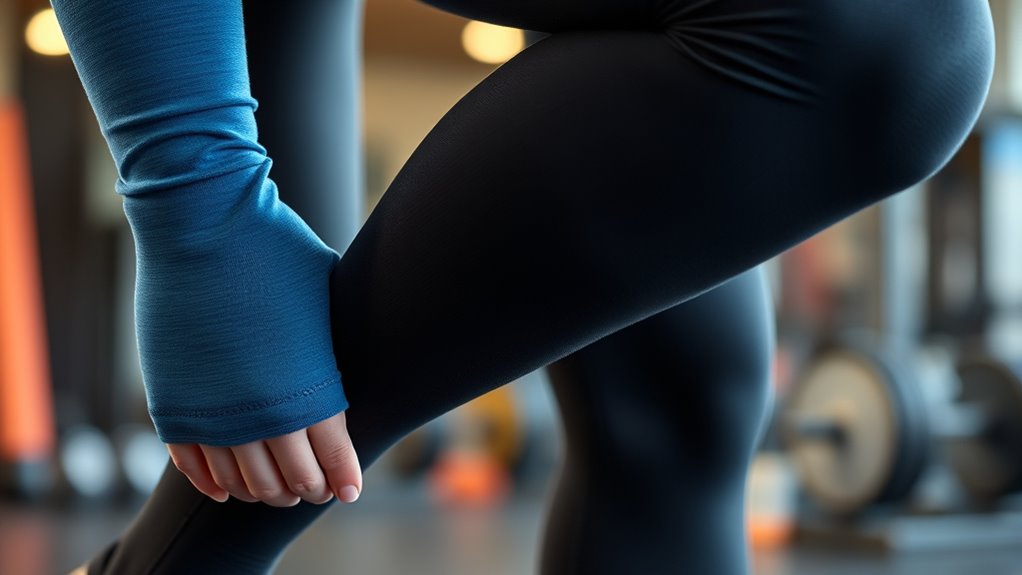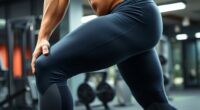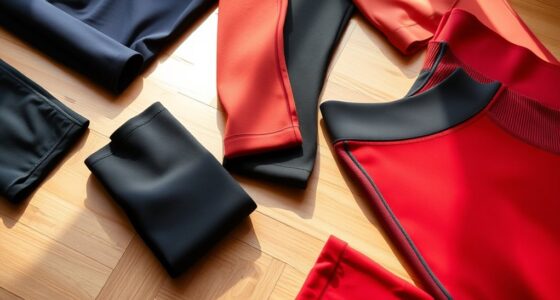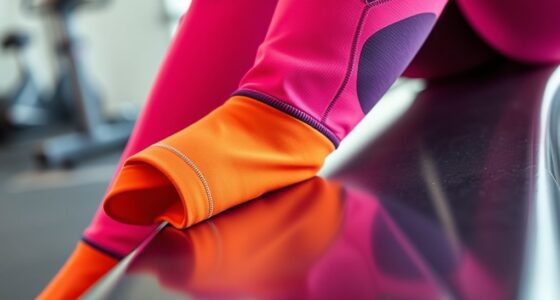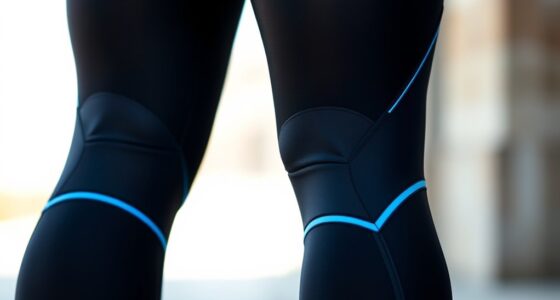Recovery sleeves fit tightly around specific muscles and are lightweight, making them ideal for targeted recovery and longer wear. Compression tights cover your entire legs with thicker support, great for intense workouts and full-leg support. Both improve blood flow, reduce soreness, and support circulation, but their comfort and fit differ. Choosing depends on your activity level and recovery needs—if you want more details, you’ll find helpful insights in the following overview.
Key Takeaways
- Recovery sleeves are lightweight, less restrictive, and ideal for extended wear and light recovery post-training.
- Compression tights provide full-leg support during or after intense workouts, aiding muscle stabilization and circulation.
- Sleeves target specific areas for localized compression, while tights offer comprehensive support for the entire leg.
- Proper sizing ensures maximum effectiveness; sleeves require snug fit without slipping, tights need precise sizing to prevent discomfort.
- Both options enhance blood flow and reduce soreness, but choose based on activity intensity, duration, and recovery needs.
Understanding the Design and Fit of Recovery Sleeves and Compression Tights

Recovery sleeves and compression tights are designed to provide targeted compression to aid muscle recovery, but their structures and fits differ considerably. Material differences play a vital role; sleeves are typically made from thinner, stretchable fabrics that contour closely around the limb, while tights use thicker, more supportive materials for full-leg coverage. Proper size considerations are essential to guarantee proper compression and comfort. Sleeves need to fit snugly without slipping, often available in smaller, more flexible size ranges. Compression tights require precise sizing to avoid constriction or looseness, as improper fit can reduce effectiveness or cause discomfort. Understanding these differences helps you select the right gear for your needs, ensuring maximum compression and comfort during recovery. Additionally, proper installation and regular maintenance of your recovery gear can enhance safety and effectiveness. Regularly checking the fit of your sleeves and tights ensures they continue to provide optimal compression over time. Being aware of material properties can further improve your choice by matching the gear to your activity level and recovery needs. Recognizing how compression levels vary between products can also help tailor your recovery strategy more effectively.
Benefits for Muscle Recovery and Performance Enhancement

Both recovery sleeves and compression tights boost muscle recovery and enhance athletic performance by improving blood flow and reducing muscle soreness. Wearing stylish options aligned with current fashion trends can also boost your confidence and motivation. Material durability plays a key role, ensuring these garments withstand intense workouts and frequent use without losing compression benefits. Well-made fabrics help maintain consistent compression levels, supporting faster recovery and better performance over time. Additionally, these garments can help stabilize muscles during activity, reducing fatigue and risk of injury. When you choose high-quality, durable materials, you’re investing in gear that supports your training goals while keeping you fashionable. Proper fit and size are crucial for maximizing effectiveness and comfort, ensuring you get the most out of your recovery and performance. The use of mind-body connection techniques in somatic therapy highlights the importance of integrating psychological and physical approaches for holistic healing, which can be an underlying factor in athletic recovery. Incorporating advanced fabric technology can further enhance the benefits by providing better moisture-wicking and breathability. Overall, both recovery sleeves and compression tights are effective tools for optimizing recovery and boosting your athletic edge. Utilizing evidence-based practices ensures that your recovery strategies are grounded in scientific research, maximizing their effectiveness. Additionally, selecting garments with moisture-wicking properties can help keep sweat away from the skin, preventing irritation and discomfort during and after workouts.
Impact on Circulation and Swelling Reduction

Wearing recovery sleeves and compression tights can greatly enhance circulation, which plays an essential role in speeding up recovery and reducing swelling after workouts. Improved blood flow helps deliver oxygen and nutrients to muscles more efficiently, supporting tissue repair. Additionally, these garments aid in joint stabilization, which minimizes unnecessary movement that could cause inflammation. By promoting steady blood flow, they help prevent blood pooling and fluid buildup in the affected areas. This reduces swelling and discomfort, making recovery more comfortable. The gentle pressure from sleeves and tights encourages the lymphatic system to remove waste products and excess fluids. Furthermore, suitable compression levels ensure optimal support without restricting movement, enhancing overall recovery. Overall, their impact on circulation and swelling reduction is indispensable for a quicker, more effective recovery process.
Comfort, Flexibility, and Wearability During and After Exercise
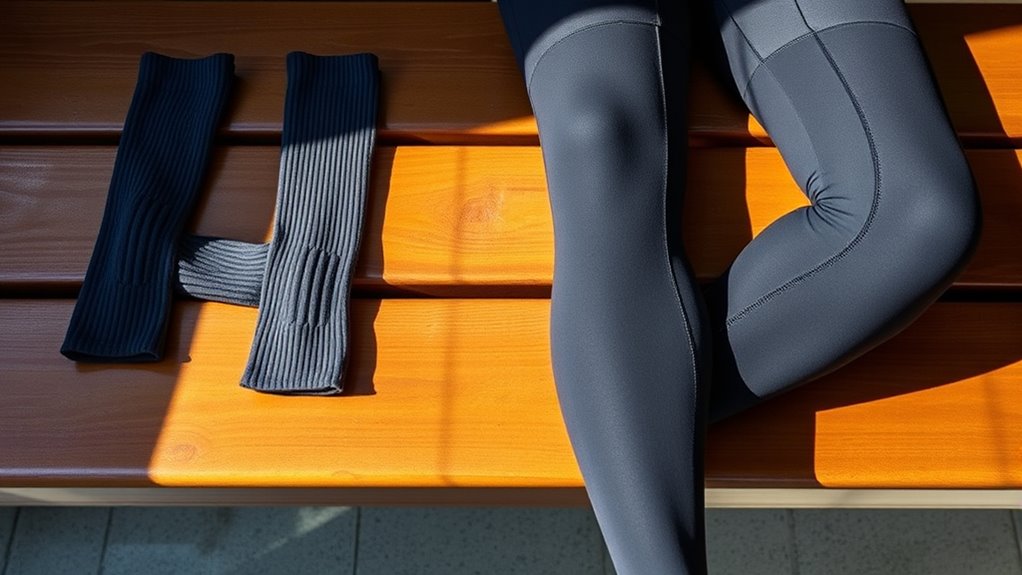
When choosing between recovery sleeves and compression tights, comfort, flexibility, and wearability are key factors to contemplate during and after exercise. Recovery sleeves often feel lightweight and less restrictive, making them easier to wear for extended periods. Compression tights, on the other hand, provide full coverage and support, which some find more comfortable during intense workouts. Fashion trends influence their design, with popular brands offering sleek, stylish options that blend performance and style. Brand popularity plays a role in perceived comfort, as trusted brands tend to prioritize fabric quality and fit. Additionally, understanding the material composition of these garments can help you select options that enhance breathability and moisture-wicking. Exploring the science of compression can also guide you to choose garments that optimize blood flow and recovery. Incorporating security measures in the manufacturing process can ensure better protection against data breaches and counterfeit products. Considering the emotional benefits of wearing comfortable and supportive gear can motivate consistent use and enhance workout satisfaction. Moreover, the fit and sizing of compression gear are crucial for ensuring that the benefits of compression are maximized without causing discomfort. Ultimately, your choice depends on personal preference, but both options aim to maximize wearability, ensuring you feel supported and comfortable before, during, and after your workout.
Choosing the Right Option Based on Your Training Goals

Your training goals influence whether recovery sleeves or compression tights suit you best. If you prioritize faster recovery, you might prefer options with higher support and compression levels, especially after intense sessions. Consider your workout’s intensity and duration to choose the gear that helps you recover efficiently and supports your performance. Additionally, selecting products with proper compression levels can optimize blood flow and reduce muscle soreness. Being aware of vetted products for effectiveness and safety ensures you choose reliable gear that aligns with your recovery needs. Exploring popular brands and reviews can further assist in making an informed decision. Understanding the specific needs of different breeds can also guide you in selecting the most appropriate recovery gear based on your dog’s unique characteristics.
Recovery Speed Preferences
Choosing the right recovery method depends largely on your training goals and how quickly you want to bounce back. If rapid recovery is your priority, compression tights can be more effective due to their consistent pressure, aiding faster muscle repair. Recovery sleeves, on the other hand, offer a more relaxed fit, which might suit those who prefer a gentler, less restrictive option. When selecting between the two, consider current fashion trends—some sleeves are designed with stylish elements, making recovery time part of your overall look—and material sustainability, since eco-friendly fabrics are increasingly popular. Your choice should align with your personal preferences for recovery speed and comfort, ensuring you stay motivated and ready for your next session.
Support and Compression Levels
Selecting the right recovery option depends on your training objectives and how much support or compression you need. To choose wisely, consider these factors:
- Higher compression offers better support and promotes circulation, aiding recovery.
- Moderate compression balances support with comfort, ideal for longer wear.
- Fabric breathability impacts comfort—opt for breathable materials if you’ll be active.
- Aesthetic appeal matters—choose styles that boost confidence and motivate you.
Training Intensity and Duration
The intensity and duration of your training sessions directly influence whether recovery sleeves or compression tights are more suitable. If you engage in high-intensity, longer workouts, compression tights may be better, offering maximum support and promoting blood flow. However, if your sessions are shorter or less intense, recovery sleeves provide targeted compression without sacrificing comfort. Material breathability becomes vital here; for longer or more intense sessions, choose options with breathable fabrics to prevent overheating and sweat buildup. Additionally, consider aesthetic appeal—if you prefer a sleek look during lighter sessions, recovery sleeves often offer a more discreet fit. Ultimately, matching your gear to your training intensity and duration guarantees ideal recovery, comfort, and performance.
Practical Tips for Using Recovery Sleeves and Compression Tights Effectively

To get the most benefit from recovery sleeves and compression tights, it’s important to use them correctly and consistently. First, choose the right fit—tight enough to compress but not restrict circulation. Second, consider fashion trends and color options to match your workout wardrobe and boost motivation. Third, wear them immediately after training to enhance recovery, or during light activity for ongoing support. Fourth, alternate between different styles to prevent fatigue and keep your routine fresh. Remember, consistency is key, so incorporate them into your post-training routine regularly. By paying attention to fit, style, timing, and variety, you’ll maximize their benefits and stay motivated to recover faster and perform better in your next workout.
Frequently Asked Questions
How Long Should I Wear Recovery Sleeves or Compression Tights Post-Workout?
When figuring out how long to wear recovery sleeves or compression tights after your workout, follow the duration guidelines and wearing tips provided by the manufacturer or a healthcare professional. Usually, you should wear them for 1 to 2 hours post-exercise, or as recommended. This helps optimize recovery, reduce soreness, and improve circulation. Remember to listen to your body and avoid over-tightening to ensure comfort and effectiveness.
Are Recovery Sleeves or Compression Tights Suitable for All Sports?
While it’s tempting to think recovery sleeves or compression tights are a one-size-fits-all solution, their athletic versatility and sport-specific design matter. You’ll find they work well for many sports, like running or cycling, but may not suit others, such as swimming or gymnastics. Always consider your activity’s demands and choose gear tailored to your sport for ideal support and comfort.
Can These Garments Prevent Injuries During Training?
You wonder if these garments can prevent injuries during training. While they don’t guarantee injury prevention, they do offer muscle support and enhance circulation, which can reduce fatigue and muscle soreness. By improving blood flow, they help your muscles recover faster and stay more resilient. Wearing them might lower your risk of strains or overuse injuries, making your training safer and more effective.
Do Recovery Sleeves or Compression Tights Help With Chronic Pain?
Imagine compression therapy transforming your chronic pain into a distant memory! Recovery sleeves and compression tights can indeed help by improving blood flow and reducing inflammation, which eases discomfort. While they won’t erase pain instantly, they support your body’s healing process. Wearing them regularly might make a noticeable difference, turning everyday pain into manageable discomfort. So, yes, these garments can be a helpful tool in managing chronic pain over time.
How Do I Clean and Maintain These Compression Garments Properly?
To keep your compression garments in top shape, wash them inside out with cold or warm water, avoiding fabric softeners, which can break down the fabric’s elasticity. Use a gentle cycle and air dry instead of tumble drying to prevent damage. Proper maintenance guarantees they stay effective and last longer, so follow these tips regularly to preserve their compression benefits and comfort.
Conclusion
Choosing between recovery sleeves and compression tights is like picking the right tool for a job—you’ll want what fits your goals best. Both options work like a gentle tide, helping your muscles recover and reducing swelling. Whether you prefer the snug hug of tights or the targeted support of sleeves, using them correctly can turn your post-workout routine into a smooth sailing voyage. Find what suits you, and let your recovery flow effortlessly.
